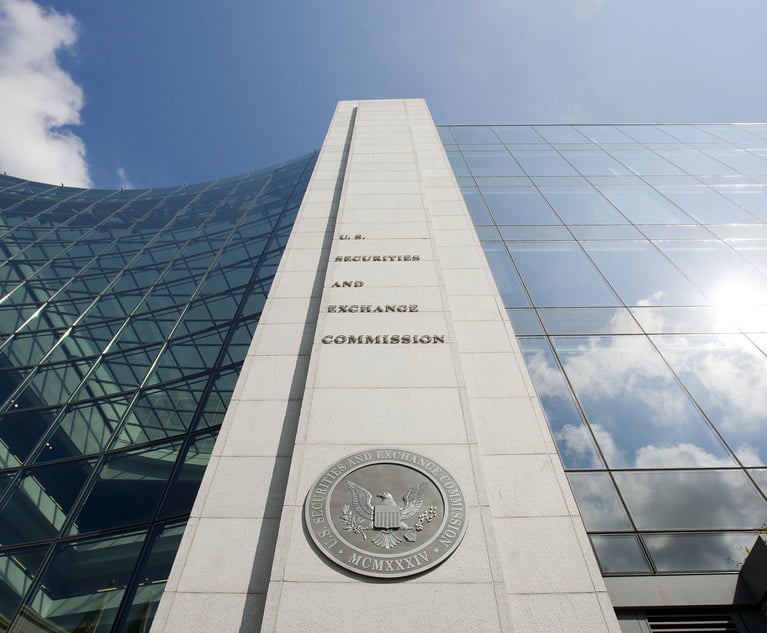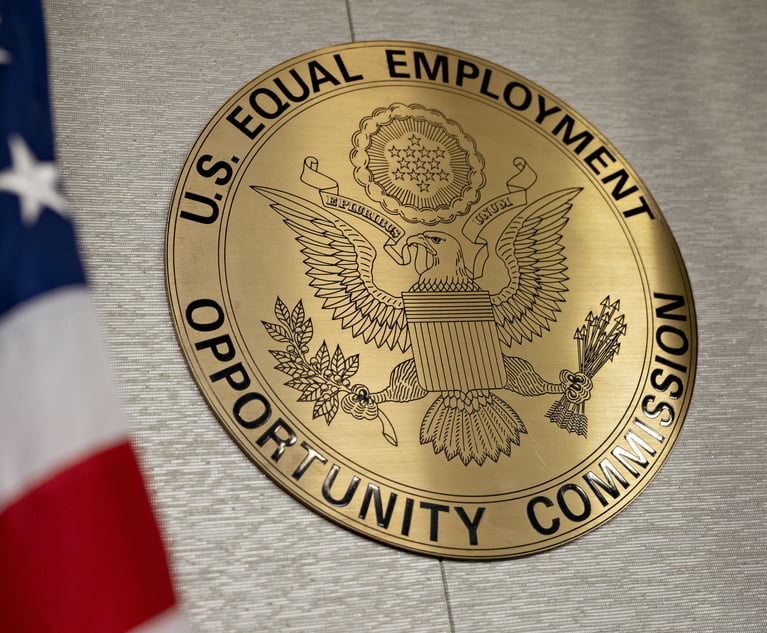China's New Tort Law Raises Questions in an Uncertain Civil Landscape
But in addition to new questions, it offers some guidance.
May 31, 2010 at 08:00 PM
6 minute read
Online Exclusive: China Addresses Privacy in New Law
Whatever the failings of China's new Tort Liability Law, critics will be hard-pressed to argue it was hastily conceived. When the Standing Committee of the National People's Congress (NPC) passed the new law on Dec. 26, 2009, it had faced nearly eight years of consultation, debate and revision. The law, which takes effect on July 1, is a milestone in a country that already hosts more than one million tort actions annually.
While Chapter VI of the General Principles of Civil Law had provided some guidance on tort liability since its enactment in 1986, it left a convoluted patchwork of disconnected and haphazard laws and administrative measures, which has driven litigation.
“In China, finding the law is half the battle,” says Richard Goetz, who leads Dykema Gossett's international practice group.
In large measure, the Tort Liability Law ameliorates the problem. It covers a wide range of subject matter, including product liability, environmental pollution, hazardous activity, motor vehicle accidents and medical malpractice. The law also promulgates general rules regarding causation, burden of proof, damage calculations, and joint and several liability.
In addition to damages, the law provides for specific performance remedies including orders to halt acts of infringement, remove unlawful obstacles, eliminate dangers, return property, restore property to its original condition, apologize or take other remedial actions.
“The Tort Liability Law is a significant step toward the creation of a comprehensive Chinese civil code in the future,” says Robert Kwauk, who manages Blake, Cassels & Graydon's office in Beijing. “It significantly expands protection for victims of tortious acts.”
For example, the law is the first statute to ensure compensation for mental distress; provide methods for calculating damages for physical injuries; clarify principles of causation; set up a recall system that attracts punitive damages in product liability cases; and address torts committed online.
“By adopting a basic tort law, the NPC is sending a message to the courts to take these issues seriously,” says James Zimmerman, a partner at Squire, Sanders & Dempsey.
Rights and Remedies
Fortunately, and unlike some other Chinese enactments, the law is not aimed at foreign corporations.
However, that's not to say it brings no increased risk to U.S. and other foreign companies.
“The law will in all likelihood make China an even more litigious jurisdiction,” Kwauk says. “And while it doesn't treat foreign companies differently from domestic concerns, tortious acts committed by foreigners that victimize local citizens may well resonate more negatively and engender greater outrage.”
As Associate General Counsel, International Operations, at Ford Motor Co., Goetz was instrumental in establishing operations in China, and he is of similar mind on the new law.
“My general impression is that Chinese suits are much more frequently aimed at premium foreign brands as opposed to domestic brands or run-of-the-mill imports,” he says.
Of particular concern to U.S. companies is the new law's broad scope. It specifically protects civil rights including the right to life, health, reputation, honor, self-image, marriage, privacy, ownership, security interests and intellectual property. These combine with a catch-all clause for tortious acts in general to give claimants almost unlimited causes of action.
Of particular significance are the provisions that make employers vicariously liable for damage caused by employees in the course of their duties and impose strict liability on polluters, even where a third party has actually caused the environmental damage. It also mandates liability for manufacturers or sellers of defective products, regardless of whether the manufacturer or seller is at fault, expressly articulating a right to punitive damages where a defendant knowingly produces or sells defective products that cause injury.
Yet despite its broad ambit, the law makes no mention of business-related torts such as interference with contracts or economic relationships, fraud, misrepresentation or unfair competition.
“While some of these principles are generally mentioned in other laws such as the country's Contract Law, Unfair Competition Law and Anti-Monopoly Law, they are not defined as compensable torts,” Zimmerman says.
Work in Progress
In addition, considerable uncertainty remains regarding the Tort Liability Law's application. As with most Chinese enactments, the devil is in the details and the details are lacking. But some Chinese laws, like labor and foreign investment legislation, are at least the province of a regulating authority. There is, however, no authority regulating the Tort Liability Law.
“There is no opportunity for consultation with any government authority before the fact,” Kwauk says.
And in some respects, the law lags behind existing judicial precedent. In 2003, for example, China's Supreme Court created a set of detailed rules for determining compensation for bodily injury.
“Those rules are much more practical than the very general rules in the Tort Liability Law, which will be difficult to apply in practice without guidance or interpretation,” Kwauk says.
Furthermore, the law does not set out a procedural scheme for invoking the various remedies available, provides no guidance as to how damages for mental distress or punitive damages will be calculated, makes no references to potential defenses such as consent, and lacks detailed definitions of key terms including negligence, gross negligence, intentional acts, fraud, misrepresentation and reasonable care.
“The lack of detail and the absence of key statutory definitions means that the various courts and agencies involved could refuse to apply or misapply the law,” Zimmerman says.
Regulating Risk
Experience with other general statutes suggests that eventually guidelines and interpretations will emerge.
“The Supreme Court will almost certainly issue guidance on various issues [the new law raises] from time to time,” Kwauk says.
What seems certain is that China's high court won't issue guidance until government policy emerges.
“The authorities have not reached a consensus regarding a variety of issues, so it is difficult to tell what detailed rules will be introduced,” says Xi Liao, an attorney at Hogan & Hartson's Beijing office.
Until then, as the law takes effect, risk management is the order of the day.
Close attention to the emergence of guidance is also critical, as is an audit of internal regulations and management policies to minimize the risk of contravention.
Where appropriate, companies should revisit their consumer or professional labelling practices, product use instructions and warnings, and crisis management policies in the event of adverse developments that might engage the Tort Liability Law.
This content has been archived. It is available through our partners, LexisNexis® and Bloomberg Law.
To view this content, please continue to their sites.
Not a Lexis Subscriber?
Subscribe Now
Not a Bloomberg Law Subscriber?
Subscribe Now
NOT FOR REPRINT
© 2025 ALM Global, LLC, All Rights Reserved. Request academic re-use from www.copyright.com. All other uses, submit a request to [email protected]. For more information visit Asset & Logo Licensing.
You Might Like
View All

Trending Stories
- 1Trump's DOJ Files Lawsuit Seeking to Block $14B Tech Merger
- 2'No Retributive Actions,' Kash Patel Pledges if Confirmed to FBI
- 3Justice Department Sues to Block $14 Billion Juniper Buyout by Hewlett Packard Enterprise
- 4A Texas Lawyer Just Rose to the Trump Administration
- 5Hogan Lovells Hires White & Case Corporate and Finance Team in Italy
Who Got The Work
J. Brugh Lower of Gibbons has entered an appearance for industrial equipment supplier Devco Corporation in a pending trademark infringement lawsuit. The suit, accusing the defendant of selling knock-off Graco products, was filed Dec. 18 in New Jersey District Court by Rivkin Radler on behalf of Graco Inc. and Graco Minnesota. The case, assigned to U.S. District Judge Zahid N. Quraishi, is 3:24-cv-11294, Graco Inc. et al v. Devco Corporation.
Who Got The Work
Rebecca Maller-Stein and Kent A. Yalowitz of Arnold & Porter Kaye Scholer have entered their appearances for Hanaco Venture Capital and its executives, Lior Prosor and David Frankel, in a pending securities lawsuit. The action, filed on Dec. 24 in New York Southern District Court by Zell, Aron & Co. on behalf of Goldeneye Advisors, accuses the defendants of negligently and fraudulently managing the plaintiff's $1 million investment. The case, assigned to U.S. District Judge Vernon S. Broderick, is 1:24-cv-09918, Goldeneye Advisors, LLC v. Hanaco Venture Capital, Ltd. et al.
Who Got The Work
Attorneys from A&O Shearman has stepped in as defense counsel for Toronto-Dominion Bank and other defendants in a pending securities class action. The suit, filed Dec. 11 in New York Southern District Court by Bleichmar Fonti & Auld, accuses the defendants of concealing the bank's 'pervasive' deficiencies in regards to its compliance with the Bank Secrecy Act and the quality of its anti-money laundering controls. The case, assigned to U.S. District Judge Arun Subramanian, is 1:24-cv-09445, Gonzalez v. The Toronto-Dominion Bank et al.
Who Got The Work
Crown Castle International, a Pennsylvania company providing shared communications infrastructure, has turned to Luke D. Wolf of Gordon Rees Scully Mansukhani to fend off a pending breach-of-contract lawsuit. The court action, filed Nov. 25 in Michigan Eastern District Court by Hooper Hathaway PC on behalf of The Town Residences LLC, accuses Crown Castle of failing to transfer approximately $30,000 in utility payments from T-Mobile in breach of a roof-top lease and assignment agreement. The case, assigned to U.S. District Judge Susan K. Declercq, is 2:24-cv-13131, The Town Residences LLC v. T-Mobile US, Inc. et al.
Who Got The Work
Wilfred P. Coronato and Daniel M. Schwartz of McCarter & English have stepped in as defense counsel to Electrolux Home Products Inc. in a pending product liability lawsuit. The court action, filed Nov. 26 in New York Eastern District Court by Poulos Lopiccolo PC and Nagel Rice LLP on behalf of David Stern, alleges that the defendant's refrigerators’ drawers and shelving repeatedly break and fall apart within months after purchase. The case, assigned to U.S. District Judge Joan M. Azrack, is 2:24-cv-08204, Stern v. Electrolux Home Products, Inc.
Featured Firms
Law Offices of Gary Martin Hays & Associates, P.C.
(470) 294-1674
Law Offices of Mark E. Salomone
(857) 444-6468
Smith & Hassler
(713) 739-1250







